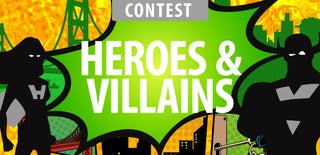Introduction: Dr. Doom Cape: Scaled, Mini/full
My daughter's favorite villain is Dr. Doom. We decided to embark on a project to make his hooded cape. Who wouldn't want a Dr. Doom cape?
My previous experience with creating sewing project instructables is that sometimes the large size makes for bulky and clumsy photos. I decided to do something different with this one: create a mini version alongside the full-size to better illustrate the process. An added benefit of doing a scaled project was in that creating a mock-up it allowed any tinkering with the design project to be done at an early stage where changes are light and easy.
Step 1: Determining Scale
I have an adjustable, human-sized dress form and then a decor pin cushion one that stands at about 13" high.
As my daughter is about 5'5",this worked perfectly for a scale of 1:5.
(13 x 5 = 65, 65/12 = 5.416)
I found some lovely green wool and lining in my stash. Both amounts were large enough to accommodate the hooded cape. I used muslin and a silky remnant for the mini version.
Step 2: Patterning and Cutting
1. The pattern on muslin, simple shapes, utilizing all the fabric.
2. Repeated on the wool. (we ended up not using the pockets, but at least we'll have the pieces in case we want to add them later)
3-7. Pieces cut out on mock-up and full size, including linings
Step 3: Tweaking and Sewing
1. After stitching the hood as is, I decided it would look better rounded, so I removed the stitching and cut off the peak.
2. I also wanted more volume at the bottom of the hood, so ballooned that out a bit on the full size version.
3/4. sewing right sides of each hood half together, leaving front and bottom open. Repeat with linings.
5-9. Stitch cape outer to lining, leaving entire top open. Trim away bulk of seam allowance.
Step 4: Ironing
1-3. Press all stitched pieces, then turn right-side out and press again. You want all edges crisp, and hood seam allowances pressed open.
4/5. Right sides of hood pieces pinned to each other and stitched
6/7. Turn right sides out and press. I edge-stitched the full-size version to create a crisp line.
Step 5: Pleating of Cape
1/3. Find center by folding in half, then stitching a short line down.
4-11. Continue simple pleating by creating folds, pinning and stitching down. The goal is to create a length along top of cape that matches the bottom of hood's cape, which you will sew together.
Step 6: Attaching Hood to Cape
1-4. Pin then sew just the outer layer of the hood's bottom to both layers of the cape's top, right sides together, leaving the hood lining free.
5-8. Fold under hood lining's seam allowance and pin to cape, through all thicknesses. Stitch.
9/10. Top stitch entire cape edge, creating crisp edge.
Step 7: Fastener
I loved this part. This is where the difference in fasteners came in, so each solution was unique.
1. For the mini version I merely used braided trim to represent the chain and two buttons for the medallions.
2-4. The full size version introduced some resourcefulness and creativity. I purchased some bronze hanging lamp chain and small, 4" wood medallions. Both were easily obtained through amazon.
5. The cutie-pie masterfully painting the medallions to look bronze-like.
6. The finished medallions.
7/8. Sponging some gold paint onto the chain to tie in better to the medallions.
9. A little dark paint to antique and add depth.
10. The finished pair!
Step 8: Modeling for Fit and Determining Fastener Placement
1. Fits pretty well! (thought I'd change the Paris label to Latveria)
2. Look at the cool shirt my daughter painted!(Dr. Doom dominating Darth Vader.)
3. Mini version with fasteners attached.
4/5. Testing out fasteners on full-size version.
6. Drilling small holes into medallions, essentially turning them into buttons to be easily sewn onto cape.
7/8. Medallions sewn onto cape.
9. Determining length of chain.
10/11. Cut a link open to remove excess links, then opened last link to feed through other end, then closed, to create a loop to fit around and into medallions.
Step 9: The Final Product/photo Shoot!
Fun project, to be sure, especially because of the scaled element. Creating a mini version first really helped the later stages of the project go smoothly.
Now my daughter needs to figure out how to do the body armor/mask.
: )

Second Prize in the
Heroes and Villains Contest













